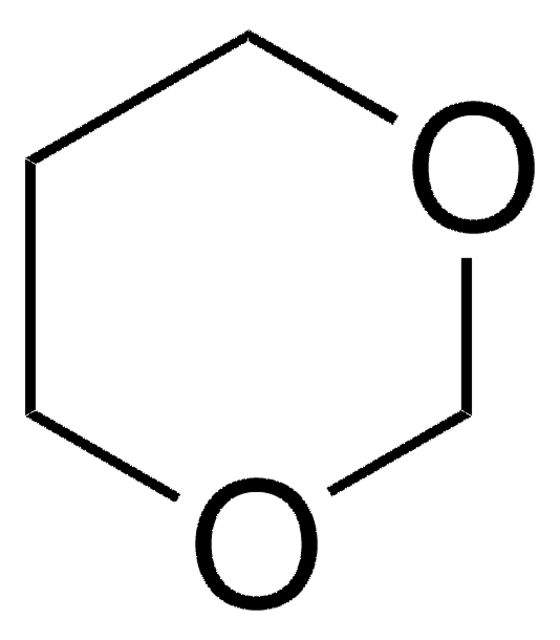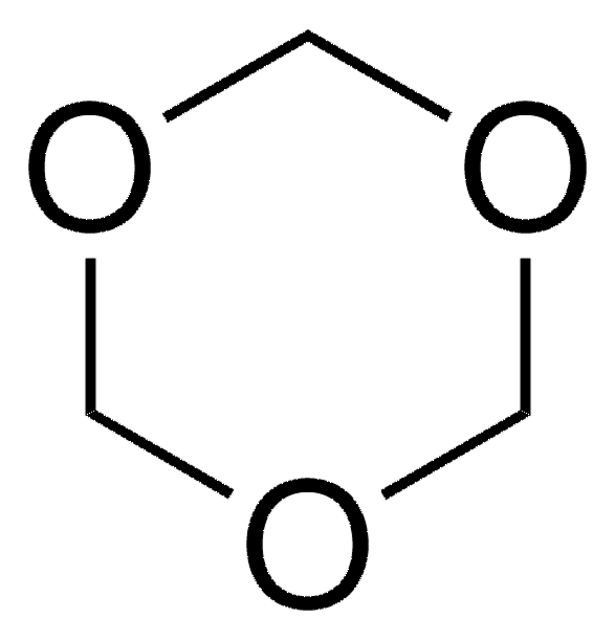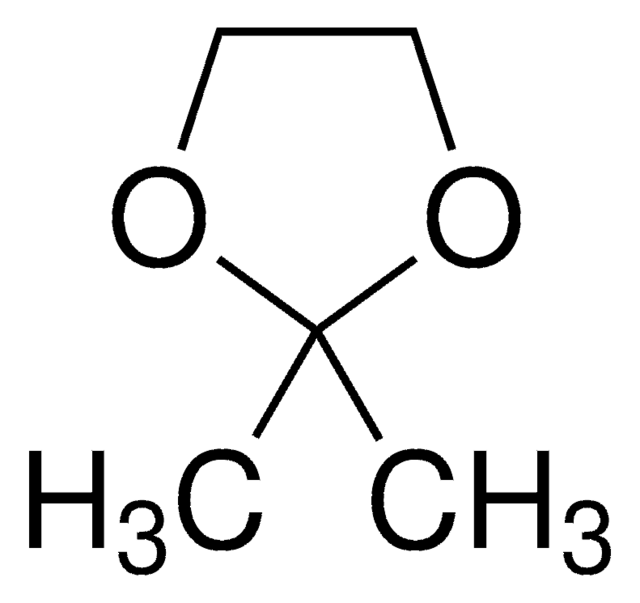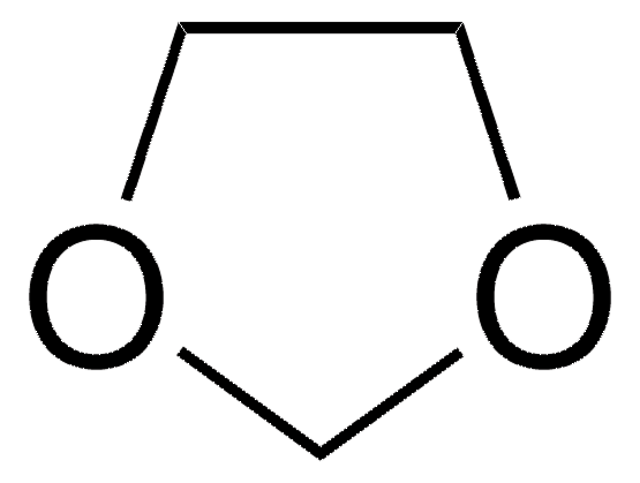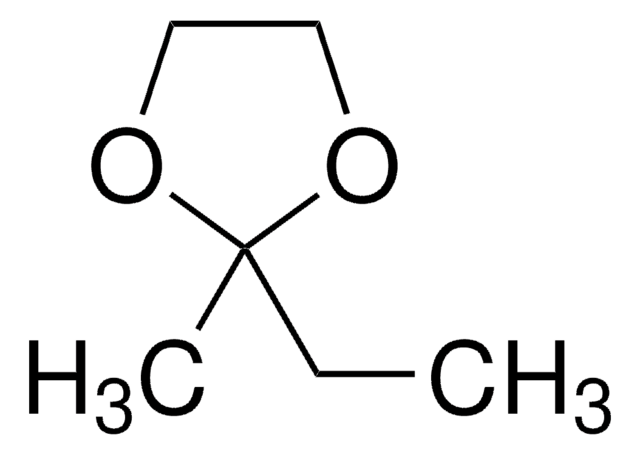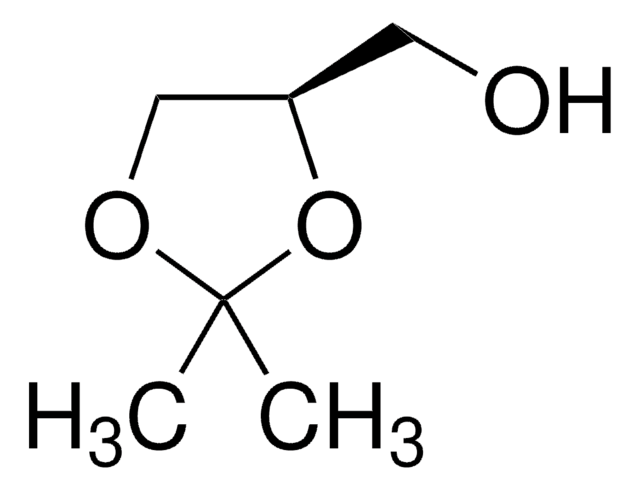292206
2-Methyl-1,3-dioxolane
97%
Sinônimo(s):
Acetaldehyde ethylene acetal
Faça loginpara ver os preços organizacionais e de contrato
About This Item
Fórmula empírica (Notação de Hill):
C4H8O2
Número CAS:
Peso molecular:
88.11
Beilstein:
102520
Número CE:
Número MDL:
Código UNSPSC:
12352100
ID de substância PubChem:
NACRES:
NA.22
Produtos recomendados
Nível de qualidade
Ensaio
97%
índice de refração
n20/D 1.398 (lit.)
p.e.
82-83 °C (lit.)
densidade
0.982 g/mL at 25 °C (lit.)
grupo funcional
ether
cadeia de caracteres SMILES
CC1OCCO1
InChI
1S/C4H8O2/c1-4-5-2-3-6-4/h4H,2-3H2,1H3
chave InChI
HTWIZMNMTWYQRN-UHFFFAOYSA-N
Procurando produtos similares? Visita Guia de comparação de produtos
Categorias relacionadas
Descrição geral
The kinetics and mechanism of the gas-phase thermal decomposition of 2-methyl-1,3-dioxolane has been studied in a static system. The infrared spectra of solid, liquid and gaseous 2-methyl-1,3-dioxolane has been studied. Low-temperature ozonation of 2-methyl-1,3-dioxolane in acetone-d6, methyl acetate and tert-butyl methyl ether has been reported.
Palavra indicadora
Danger
Frases de perigo
Declarações de precaução
Classificações de perigo
Flam. Liq. 2
Código de classe de armazenamento
3 - Flammable liquids
Classe de risco de água (WGK)
WGK 2
Ponto de fulgor (°F)
28.4 °F - closed cup
Ponto de fulgor (°C)
-2 °C - closed cup
Equipamento de proteção individual
Eyeshields, Faceshields, Gloves, type ABEK (EN14387) respirator filter
Escolha uma das versões mais recentes:
Já possui este produto?
Encontre a documentação dos produtos que você adquiriu recentemente na biblioteca de documentos.
Os clientes também visualizaram
T R Ward et al.
Toxicology and applied pharmacology, 122(2), 300-307 (1993-10-01)
Some compounds that inhibit acetylcholinesterase (AChE) activity compete directly with quinuclidinyl benzilate (QNB) binding, a muscarinic antagonist which binds to all subtypes equally, and with cis-methyldioxolane (CD), an agonist that binds with high affinity to the M2 subtype of muscarinic
S Yamada et al.
Brain research, 410(2), 212-218 (1987-05-05)
To study the role of central cholinergic mechanisms in hypertension, we have determined nicotinic and muscarinic agonist binding sites in the brain regions of stroke-prone spontaneously hypertensive rats (SHRSP), using [3H]nicotine and [3H]cismethyldioxolane (CD). There was a significant decrease in
H Tecle et al.
Life sciences, 52(5-6), 505-511 (1993-01-01)
The synthesis of a series of potent and efficacious 1-azabicyclo[2.2.1]heptan-3-one oxime muscarinic agonists is described. The oximes have extended appendages designed to span the cavity defined by the seven transmembrane helices of the muscarinic receptor. Some members of the series
T W Vickroy et al.
Federation proceedings, 43(13), 2785-2790 (1984-10-01)
The binding of agonists to muscarinic cholinergic receptors is well described by a binding model of multiple affinity states (superhigh, high, and low) in most central and peripheral tissues. Although previous studies of the influences by divalent cations, guanine nucleotides
T R Ward et al.
Brain research bulletin, 39(1), 49-55 (1996-01-01)
Recent reports indicate that organophosphate insecticides, in addition to inhibiting acetylcholinesterase activity, can bind directly at a subset of muscarinic receptors, which also bind cis-methyldioxolane with high affinity. Muscarinic receptors are known to act through at least two second messenger
Nossa equipe de cientistas tem experiência em todas as áreas de pesquisa, incluindo Life Sciences, ciência de materiais, síntese química, cromatografia, química analítica e muitas outras.
Entre em contato com a assistência técnica